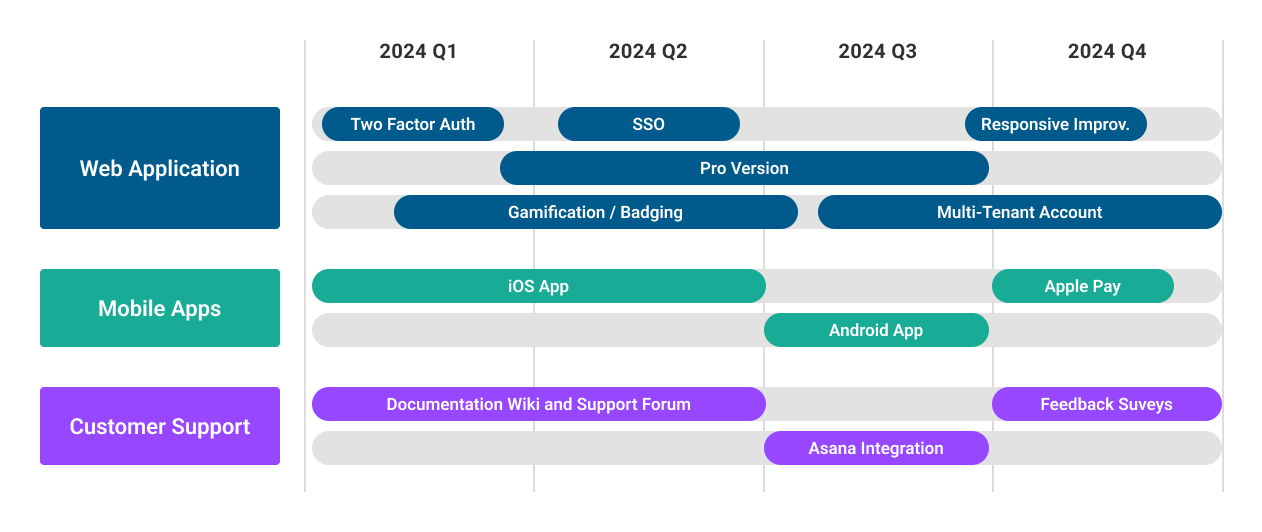Planning & Communicating Future Features

Every tech company has to deal with the orderly and inevitable evolution of their product, and it’s not an easy task. Do it right, and your product has increasing value over time. Do it wrong, and you can stunt your growth, or even potentially kill your product entirely.
In this blog we’ll talk about the right way to communicate with your users, how to manage feature requests properly, and avoid pitfalls in your product journey that can turn into a nightmare!
Listen Your Users Continuously
Your users are in a very real sense, the boss. Customers vote with their wallets, and if they are happy with what you are delivering, they’ll tend to stick around.
The good news is that your users will tell you what they want and need, and it’s easier than ever to collect user feedback and suggestions for new features.
Consider creating a focus group or an advisory panel of users that you can tap for feedback and testing of new features. It’s a cost-effective and easy way to gather input from your users.

Keep constant tabs on social media channels and consider getting a monitoring platform that can track social mentions on channels you are not directly monitoring. It’s easy to keep track of your company’s Facebook page or Reddit sub, but not the hundreds of others where someone might complain.
Also, track bugs, feature improvements, and new features separately. Obviously, bugs need to be dealt with first, with improvements and new features secondarily.
Keeping track of this constant, multichannel flow of information can be dizzying for a scaling company. Build good data collection practices to transition bug reports into your production workflow, and feature requests into a Feature Request Management platform to track and score features.
Create a Scoring Model
It’s not easy to decide what requests are highest priority and what to develop next. Consider creating a scoring model that can help you make those decisions by evaluating your tracking data. Here are some criteria to including your model:
Demand
What are the most requested features? While not always an overriding factor, it’s a big one. If you continually get a request for something, pay attention.
Feasibility
Can you actually do it either technically, or with the available resources you have?
Business Value
Does the feature have a use case that aligns with your business goals?
Vision
This is an important one. Don’t let your product stray too far from your vision. You don’t want your users to say that you have lost your focus and core values.
Deal Size
Often you will get requests for features with the promise of a sale when completed. If you are talking about a couple of seats, it might not be worth it. If it’s a large sale with a company changing ARR, then it’s worth considering.
Quick Wins
Look for small updates that can have a big impact. Those minor updates can give you a nice communication touchpoint with your users too.
Create a Product Roadmap
The purpose of the Product Roadmap is to have an actionable plan for your product features that aligns with the business goals of your company and flows out of your feature request tracking data. Your Product Roadmap articulates your vision for the product and makes sure that all stakeholders, including your customers, are aligned.

We’ve seen far too many startups that don’t have a Product Roadmap, and their products and teams don’t have a focused strategy on how their products evolve and improve over time. This includes your short-term tasks and production, your intermediate goals, and your long-term vision.
For your users, communication on those stages is important because it allows them to understand where you are heading with the product, and to give their input to validate your plan, and to chime in on things you might have missed.
Focus on Delivering Value
You should concentrate on delivering value, not just features, which is a deeper level of analysis. As part of your Product Roadmap strategy, consider building a Value Roadmap, which highlights the values that your product will be delivering.
Key Insight
This strategic approach allows you to focus on the customer’s needs, your business objectives, and what your value proposition is.
This has the added benefit of having a more focused marketing and communication strategy. By focusing on your value proposition for each feature, it will allow you to craft much better messaging, and focus your product team on delivering features that actually make a difference.
The Importance of Communication
Your users, and potential users, will want to know what your vision for the product is, and a timeline for new features with a rollout schedule. A few ideas for regular communications and feedback:
Regular monthly communications in a newsletter or blog on the future of the product.
Conduct interviews and team sessions with your users to discuss your plans, and to find out their needs and pain points. Look for unknown opportunities that might not have been uncovered previously.
Consider publishing your Product Roadmap on your public website. Not every tech team wants to do this because it creates risk by tipping competitors to your plans, or unrealistic expectations.
Keep your communications at a high-level, BTW. You don’t need to go into the weeds, just show your vision. As you get closer to releasing features, include projected release dates when you feel confident that you can meet them.
Never Stop Prototyping and Iterating
If you follow Parux, you know we talk about the value of prototyping and iterating to solve problems and ensure that what you are building has value. Unfortunately, this often stops once the product has been released, or prototyping is only shared with internal stakeholders. Don’t make this mistake – sharing your prototypes with selected users through a focus group can make sure that your product is evolving the right way.
If It Ain’t Broke, Don’t Fix It
How many times have you downloaded that new product release of one of your crucial apps where after 5 minutes you were saying, “WTF?” It’s happened to me dozens of times, and I’m amazed at how this can happen so often.

Case in point, CRM is often cited as an example of how an industry has gone off track by creating feature after feature that have little value, complicate the product, and create barriers to user acceptance. With total or partial failure rates approaching 70%, it’s an industry where product teams have larded their products with complicated features in an arms race to nowhere.
This can happen when product teams are working in a silo, building features for them, but not their users. Or the flip side can be true too – a few vocal users can inspire a product team to build something that isn’t needed by the majority of users.
The point is that you users are a vital part of your product team. Include them in your plans, ask for their input and counsel. Treat them as if they were a true partner on your product journey, because that’s who they are.
Conclusion
Effective and strategic communication with your customers on your product plans is a vital part of your overall communications strategy. It builds trust, creates collaborative relationships with them, and allows you to share your vision with them. If you do this right, they become not just your customers, but stakeholders who think of themselves as a part of your team.
Schedule Your Free Strategic Project Review & Project Brief
Developing great digital products is our passion. Not sure how to start that journey? Let us help you find the right path. Schedule a free 1-hour consultation with our team. At the end we’ll deliver a Project Brief that will help you to crystalize your vision.
